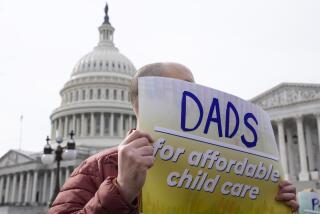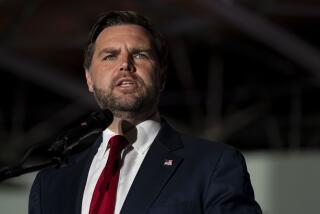Children’s healthcare dilemma
WASHINGTON — Faced with the likelihood that they will fall short in their effort to overturn President Bush’s veto of a popular health insurance program for children, congressional Democrats are confronting a difficult choice about what to do next.
Should they come up with a cheaper, scaled-back version that Bush might accept? Or should they continue to press for the full $60-billion plan Congress has passed, hoping to pressure more Republicans into breaking from the White House?
The answer could determine whether a rare bipartisan collaboration around a healthcare issue in Congress breaks down into the kind of party-line stalemate that has dominated the congressional scene in recent years.
The override vote in the House is scheduled for Thursday. Some Republicans are expected to vote against Bush, but not enough to give the bill’s supporters the two-thirds majority required to override a presidential veto.
At issue is the State Children’s Health Insurance Program, a federal-state partnership that provides medical insurance mainly to children of the working poor.
If, as expected, the attempt to override Bush’s veto fails, a leading Republican sponsor of the congressional plan said Tuesday that he would quickly move to start negotiations with the administration.
“Assuming we don’t override the veto, then I am certainly going to try to bring us all together to see what we can do to resolve this,” said Sen. Orrin G. Hatch of Utah after a Capitol Hill rally urging House Republicans to override Bush’s veto.
But many Democrats say they have already given away too much to come up with a bill acceptable to Hatch and other Republicans. It was this compromise bill that Bush vetoed.
Now, these Democrats say, they want to keep sending the congressional bill back to the White House again and again. That would wear down the opposition, they argue, by forcing Republican lawmakers to make politically unpopular votes as the 2008 election approaches.
“I would prefer another attempt in March or April of next year to see if we can get the votes for a program closer to what Congress approved,” said Rep. Henry A. Waxman (D-Beverly Hills), a leader on healthcare issues.
“Maybe the people who won’t vote to override the veto now by the spring will come to the conclusion that the program is needed. They’ll hear from constituencies,” Waxman said.
That strategy carries substantial risks, however, in terms of politics and policy. Refusing to compromise could hurt the popular program, and it could boomerang politically.
Prolonged fighting could damage the program because it would almost certainly shatter the bipartisan coalition that has supported it.
Hatch and other influential Republican senators who backed the version of the plan that Congress passed and Bush vetoed would want no part of confrontational tactics, a senior GOP aide said.
“If the veto is sustained, the next step has to be negotiating a bill that can become law,” said the aide, who asked not to be identified because of the sensitivity of the issue.
In purely political terms, some Democrats think sharpening the divide on an emotionally charged issue like children’s healthcare could pay off at the polls in 2008.
Others worry that it might be Democrats who would be punished by voters if they appeared to be playing politics with the issue.
“Democrats have to decide whether they want to adopt a strategy that is much more likely to produce a [political] issue than a bill, or whether they want to take half a loaf now and then come back in 2009 and get the other half, and then some,” said William A. Galston, who was a senior domestic policy advisor for President Clinton.
Bush has offered a five-year program extension that would cost $30 billion. But independent analysts say that’s not enough money to sustain coverage for the 6 million children now covered, let alone enroll an additional 4 million that Congress wants to reach.
About 9 million children are currently uninsured, and the number has been growing as healthcare costs have risen and employers have cut back on family coverage.
Both sides have hinted at compromise.
Bush has said he could agree to spending more money if eligibility for the program is not extended into the middle class. The current program permits states to set eligibility requirements and some want to extend the program to uninsured children in middle-class families.
The administration has argued that the current bill could encourage government-subsidized coverage for families that could afford private health insurance.
Lately, House Speaker Nancy Pelosi (D-San Francisco) has steered away from discussing eligibility for middle-class families, saying her central goal is to cover 10 million children.
Meanwhile, California and other states are making plans for dropping children from the program or setting up waiting lists should the political battle jeopardize funding. Congress and the president agreed to a temporary extension through mid-November, but what will happen beyond that remains uncertain.
In California, where the program is known as Healthy Families, the average child enrolled is in a family earning a little more than 1 1/2 times the federal poverty level, or about $33,660 for a family of four.
“We are already in a new federal fiscal year, and we do not know how much money we’re going to have,” said Lesley Cummings, Healthy Families administrator. “That is a very hard spot.”
ricardo.alonso-zaldivar@latimes.com
More to Read
Get the L.A. Times Politics newsletter
Deeply reported insights into legislation, politics and policy from Sacramento, Washington and beyond. In your inbox three times per week.
You may occasionally receive promotional content from the Los Angeles Times.










